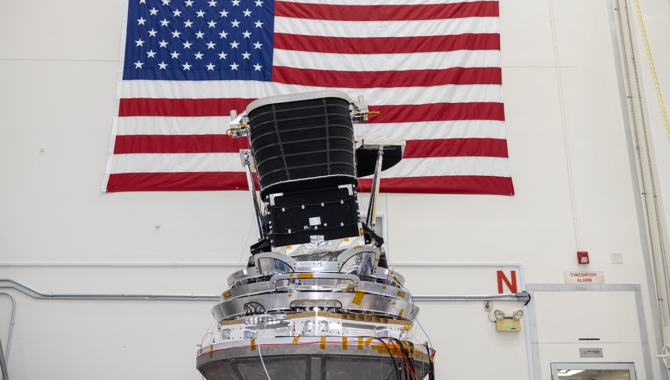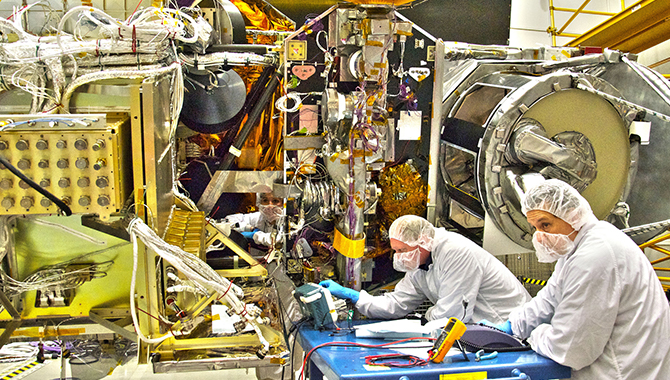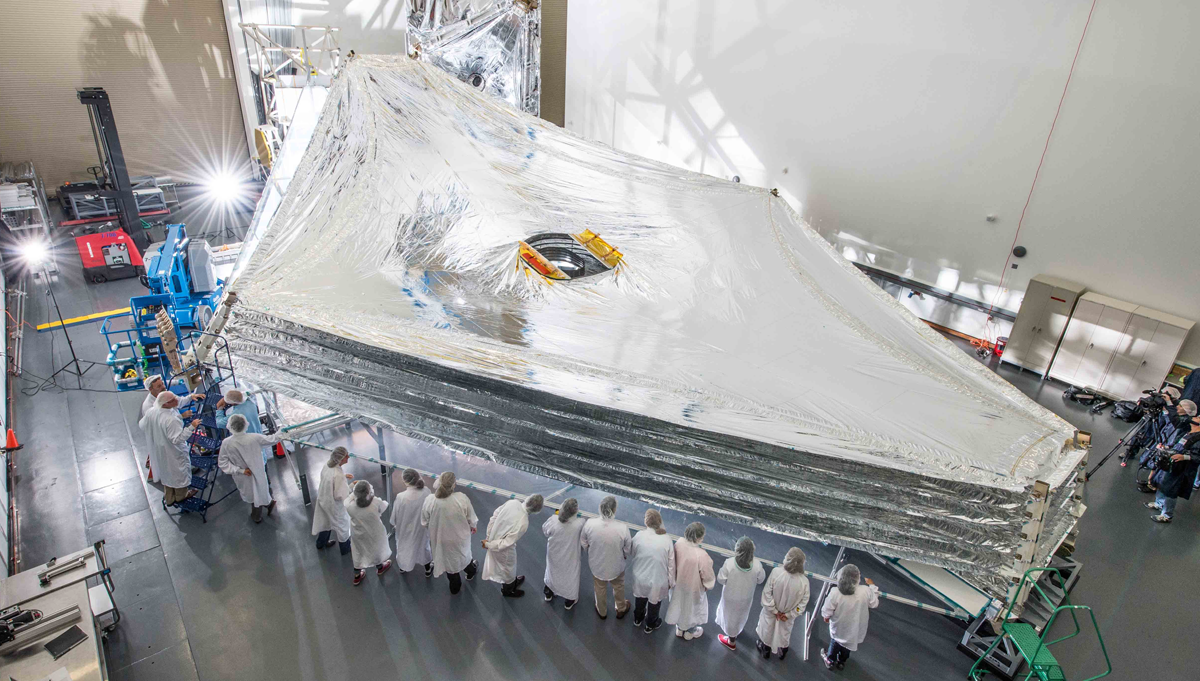
The telescope for NASA’s SPHEREx mission undergoes testing at JPL. It is tilted on its base so it can see as much of the sky as possible while remaining within the protection of three concentric photon shields. Photo Credit: NASA/JPL-Caltech
SPHEREx team will seek answers to three key questions.
Earlier this year, a team of more than 20 people, working in a basement clean room at Caltech University, went through weeks of painstaking preparation to place a new NASA telescope into a large stainless-steel chamber designed and built by the Korean Astronomy and Space Science Institute to simulate the frigid vacuum of space. Testing the telescope’s detectors and optics, which operate within tolerances of 0.0003 inches, in these conditions was an important step for a small telescope designed to study big questions.
The telescope is part of a mission known as SPHEREx, an acronym for Spectro-Photometer for the History of the Universe, Epoch of Reionization and Ices Explorer. Managed by NASA’s Jet Propulsion Laboratory (JPL), SPHEREx will orbit Earth, creating a near-infrared spectroscopic survey of the entire sky, gathering rich data on about 500 million galaxies over a two-year primary mission.

This cross-sectional illustration of the SPHEREx spacecraft shows how the concentric photon shields protect the telescope from light and heat sources. Illustration Credit: NASA
On orbit, the spacecraft will be about 8.5 feet high and about 10.5 feet wide. The telescope will be surrounded by a series of three concentric photon shields that will protect the sensitive instrument from the light and heat of both Earth and the Sun. Each of the shields comprises an aluminum honeycomb structure sandwiched between two thin sheets of aluminum. Beneath the shields is a V-groove radiator, designed to keep the telescope at a constant -350 degrees Fahrenheit.
“SPHEREx is NASA’s latest explorer mission in astrophysics. It’s a small telescope, but it has this unique and powerful capability of doing spectroscopy everywhere,” said Dr. James Bock, an astrophysicist at JPL and the SPHEREx Principal Investigator, speaking in a 2022 JPL video about the mission. NASA’s Astrophysics Explorers Program develops small- and medium-class missions focused on filling scientific gaps between larger missions.
Unlike the Hubble Space Telescope and James Webb Space Telescope, which capture small areas of the sky in staggering detail, SPHEREx will scan the full sky every six months, creating an unprecedented map in 96 different color bands, far more detail than previous maps.
“The great thing about SPHEREx is not only will we view the entire sky four times, but we will see it in nearly a hundred near infrared colors, and that’s really never been done before,” said Beth Fabinksy, SPHEREx Deputy Project Manager, in the same video. “We are going to survey the entire celestial sphere and collect the dataset that will help us answer three fundamental science questions.”
One of those questions involves cosmic inflation, a theory that in a fraction of a second 13.8 billion years ago the Universe expanded faster than the speed of light. Some cosmologists theorize that many of the large-scale characteristics of the Universe that we observe today can trace their origins to this inflation. By mapping the positions of galaxies, the SPHEREx team will be able to examine the data for statistical patterns that would be expected by cosmic inflation, patterns that could explain the physics of the expansion.
“…This is really a profound idea and we’re very interested to test it. And so, one way to do this is to look at how matter is distributed over the universe. We want to map hundreds of millions of galaxies in three dimensions,” Bock said. “We can measure these galaxies over … the entire sky, and we want to cover the full range of distances from today to as far back as we can see.”
The team will also study the Epoch of Reionization, a period following the Cosmic Dark Ages, when the first stars—hundreds of times larger than our Sun and burning much brighter—began to form and become supernovae. SPHEREx maps will enable the team to examine unique measurements of spatial fluctuations in the extragalactic background light during this epoch caused by early dwarf galaxies.
“We know there are about a hundred billion galaxies in the universe, maybe more, but we still don’t have a good understanding how these galaxies came to be,” said Dr. Asantha Cooray, a Professor of Physics & Astronomy at the University of California, Irvine, and the SPHEREx Galaxy Formation Lead. “Did they all form at the same time? Did they change in size and luminosity or brightness over time? So, the intent with SPHEREx is for us to figure out the formation history of galaxies. Where do they exactly form and how do they grow over cosmic time?”
Finally, the team will examine the maps for indications of water ice and frozen organic molecules bound to dust grains in the dense gas clouds from which young stars and planets form. Scientists believe that these clouds could seed forming planets with organic molecules and water ice, and SPHEREx data could reveal how common these conditions are.
“…We still don’t understand how water arrived at Earth. Where was it formed? How did it get here? And this is an area in which SPHEREx will make major strides,” said Dr. Gary Melnick, Smithsonian Astrophysical Observatory scientist and SPHEREx Interstellar Ices Lead. “Water molecules bounce around in interstellar space, and every once in a while, they will impact a small dust grain. When a water molecule collides with one of these dust grains, it freezes on the surface, it doesn’t leave the surface. And these ice-covered dust grains participate in the collapse to form regions where new planets are formed. SPHEREx, for the first time, will allow us to directly measure not just the location of these key ingredients, but the abundances of these key ingredients.”
Managed by JPL, SPHEREx is currently scheduled to launch no earlier than June 2024 and no later than April 2025. Ball Aerospace in Boulder, Colorado, will supply the spacecraft. The analysis of the SPHEREx data will be conducted by a team of scientists located at 10 institutions across the U.S. and in South Korea. Data will be processed and archived at IPAC at Caltech. The dataset will be publicly available. To learn more about the mission, click here.










